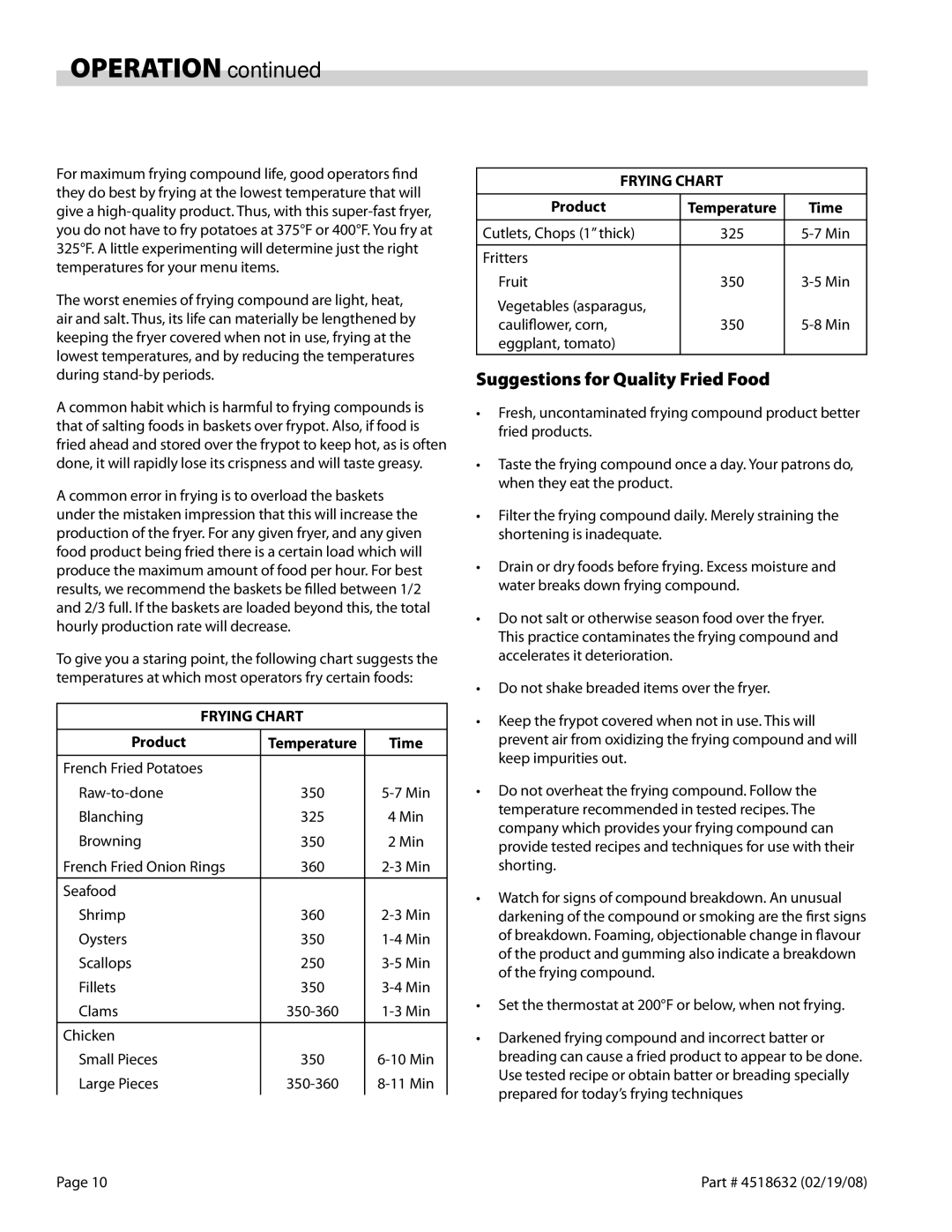
OPERATION continued
For maximum frying compound life, good operators find they do best by frying at the lowest temperature that will give a
The worst enemies of frying compound are light, heat, air and salt. Thus, its life can materially be lengthened by keeping the fryer covered when not in use, frying at the lowest temperatures, and by reducing the temperatures during
A common habit which is harmful to frying compounds is that of salting foods in baskets over frypot. Also, if food is fried ahead and stored over the frypot to keep hot, as is often done, it will rapidly lose its crispness and will taste greasy.
A common error in frying is to overload the baskets under the mistaken impression that this will increase the production of the fryer. For any given fryer, and any given food product being fried there is a certain load which will produce the maximum amount of food per hour. For best results, we recommend the baskets be filled between 1/2 and 2/3 full. If the baskets are loaded beyond this, the total hourly production rate will decrease.
To give you a staring point, the following chart suggests the temperatures at which most operators fry certain foods:
FRYING CHART
Product | Temperature | Time |
|
|
|
French Fried Potatoes |
|
|
350 | ||
Blanching | 325 | 4 Min |
Browning | 350 | 2 Min |
French Fried Onion Rings | 360 | |
|
|
|
Seafood |
|
|
Shrimp | 360 | |
Oysters | 350 | |
Scallops | 250 | |
Fillets | 350 | |
Clams | ||
|
|
|
Chicken |
|
|
Small Pieces | 350 | |
Large Pieces | ||
|
|
|
FRYING CHART
Product | Temperature | Time |
|
|
|
Cutlets, Chops (1” thick) | 325 | |
Fritters |
|
|
Fruit | 350 | |
Vegetables (asparagus, |
|
|
cauliflower, corn, | 350 | |
eggplant, tomato) |
|
|
Suggestions for Quality Fried Food
•Fresh, uncontaminated frying compound product better fried products.
•Taste the frying compound once a day. Your patrons do, when they eat the product.
•Filter the frying compound daily. Merely straining the shortening is inadequate.
•Drain or dry foods before frying. Excess moisture and water breaks down frying compound.
•Do not salt or otherwise season food over the fryer. This practice contaminates the frying compound and accelerates it deterioration.
•Do not shake breaded items over the fryer.
•Keep the frypot covered when not in use. This will prevent air from oxidizing the frying compound and will keep impurities out.
•Do not overheat the frying compound. Follow the temperature recommended in tested recipes. The company which provides your frying compound can provide tested recipes and techniques for use with their shorting.
•Watch for signs of compound breakdown. An unusual darkening of the compound or smoking are the first signs of breakdown. Foaming, objectionable change in flavour of the product and gumming also indicate a breakdown of the frying compound.
•Set the thermostat at 200°F or below, when not frying.
•Darkened frying compound and incorrect batter or breading can cause a fried product to appear to be done. Use tested recipe or obtain batter or breading specially prepared for today’s frying techniques
Page 10 | Part # 4518632 (02/19/08) |
